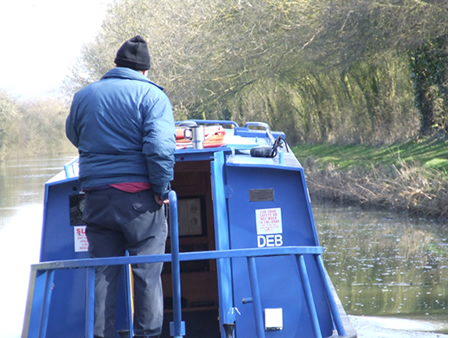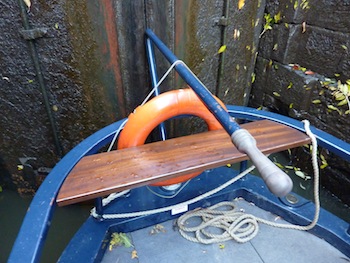How To Steer
A UK Canal Boating Article
Category : How To
If you have never been on a canal boat do not be put off as steering one is really easy and the basic skills are very easy to master.
You do not need any licence or certificate and there are no tests to pass.
We will provide you with full training and we will stay with your until you are completely happy and confident in the operation of the boat. On a canal boat holiday the whole family gets involved and with adult supervision even the kids can have a go, what other kind of holiday gives them that sort of opportunity.
The speed limit on most canals and many rivers is 4 mph but generally you will be travelling at 3 mph which is about an average walking pace. Canal boats are not fitted with speedometers but it is very important that you observe this speed limit.
You steer from the back or stern of the boat using a tiller and you push this in the opposite direction to where you want the boat to go. If you push the tiller to the right the boat would go left and if you push to the left then it would turn the boat right. Our canal boats are extremely easy to steer but what you have to remember is to think ahead because manoeuvres do take a little longer.
Narrow boats do not have brakes so give yourself plenty of time to stop, easy off the throttle, move into neutral and use short bursts in reverse to slow down. Remember it is more difficult to steer when in reverse gear. As you glide gently along the canal you will find your canal boat will steer more easily in the deeper water.
Cruise AsternThis is usually in the centre of the canal so if there are no other boats coming towards you that is your best position. Try to avoid getting close to the canal bank as the water is shallow here and may result in your boat going aground. Your canal boat will not always keep going in a straight line, even when the wheel or tiller is central, and you may need to make frequent small steering corrections.
If a manoeuvre goes wrong please do not panic, just straighten the boat up, take a deep breath and try again.
At some time during your canal boat holiday you may need to turnaround and as the canal isn’t wide enough to do this there are points along the route know as winding holes (pronounced ‘wind’ as in weather). It is at these points that you can turn your canal boat full circle.
Sometimes there may be need for you to overtake another canal boat and basically it is the same principle as driving a car. You overtake on the right hand side as you would on the road.
Do not lean out of the canal boat when it is moving and do not dangle arms and legs over the side. Canal boats are built from steel and are very heavy so they can take the odd bump or scrape but arms and legs are much more fragile.
If you do sit on the roof watch out for overhead branches and low bridges and never sit on the roof whilst the boat is in a lock. When approaching a tunnel check any notices first to see if it is wide enough for two boats to pass or if it can only take one way traffic. Look out for traffic lights, entry times and any special instructions.
Switch your headlight on in good time and leave some interior lights on for extra light. A long blast on the horn will alert other boat users that you are about to enter the tunnel. Do not sit on the roof or gunwales whist in the tunnel and keep arms and legs inside the boat. If there is a boat in front of you keep your distance and if passing another boat give plenty of clearance.
Rules of the 'road'
Keep right when passing other boats.
The maximum speed on the canal is 4 mph but the average speed is closer to 3 mph, remember you have booked a canal boat in order to slow down so do just that.
Do not create a wash as even at a low speed this can erode the canal bank or will cause a moored boat to be bumped.
Always give the on-coming canal boat sufficient space to pass.
Slow down when you see fishermen ahead and let them know you are approaching. This will give them the time they may need if they want to pull in their lines. Try to keep to the centre on the canal if you can.
You cannot cruise in the dark.
Slow right down when passing moored boats.
Never leave the engine running with no one at the helm.
Never drink and 'drive'
You do not need any licence or certificate and there are no tests to pass.
We will provide you with full training and we will stay with your until you are completely happy and confident in the operation of the boat. On a canal boat holiday the whole family gets involved and with adult supervision even the kids can have a go, what other kind of holiday gives them that sort of opportunity.
The speed limit on most canals and many rivers is 4 mph but generally you will be travelling at 3 mph which is about an average walking pace. Canal boats are not fitted with speedometers but it is very important that you observe this speed limit.
You steer from the back or stern of the boat using a tiller and you push this in the opposite direction to where you want the boat to go. If you push the tiller to the right the boat would go left and if you push to the left then it would turn the boat right. Our canal boats are extremely easy to steer but what you have to remember is to think ahead because manoeuvres do take a little longer.
Narrow boats do not have brakes so give yourself plenty of time to stop, easy off the throttle, move into neutral and use short bursts in reverse to slow down. Remember it is more difficult to steer when in reverse gear. As you glide gently along the canal you will find your canal boat will steer more easily in the deeper water.
Cruise AsternThis is usually in the centre of the canal so if there are no other boats coming towards you that is your best position. Try to avoid getting close to the canal bank as the water is shallow here and may result in your boat going aground. Your canal boat will not always keep going in a straight line, even when the wheel or tiller is central, and you may need to make frequent small steering corrections.
If a manoeuvre goes wrong please do not panic, just straighten the boat up, take a deep breath and try again.
At some time during your canal boat holiday you may need to turnaround and as the canal isn’t wide enough to do this there are points along the route know as winding holes (pronounced ‘wind’ as in weather). It is at these points that you can turn your canal boat full circle.
Sometimes there may be need for you to overtake another canal boat and basically it is the same principle as driving a car. You overtake on the right hand side as you would on the road.
Do not lean out of the canal boat when it is moving and do not dangle arms and legs over the side. Canal boats are built from steel and are very heavy so they can take the odd bump or scrape but arms and legs are much more fragile.
If you do sit on the roof watch out for overhead branches and low bridges and never sit on the roof whilst the boat is in a lock. When approaching a tunnel check any notices first to see if it is wide enough for two boats to pass or if it can only take one way traffic. Look out for traffic lights, entry times and any special instructions.
Switch your headlight on in good time and leave some interior lights on for extra light. A long blast on the horn will alert other boat users that you are about to enter the tunnel. Do not sit on the roof or gunwales whist in the tunnel and keep arms and legs inside the boat. If there is a boat in front of you keep your distance and if passing another boat give plenty of clearance.
Rules of the 'road'
Keep right when passing other boats.
The maximum speed on the canal is 4 mph but the average speed is closer to 3 mph, remember you have booked a canal boat in order to slow down so do just that.
Do not create a wash as even at a low speed this can erode the canal bank or will cause a moored boat to be bumped.
Always give the on-coming canal boat sufficient space to pass.
Slow down when you see fishermen ahead and let them know you are approaching. This will give them the time they may need if they want to pull in their lines. Try to keep to the centre on the canal if you can.
You cannot cruise in the dark.
Slow right down when passing moored boats.
Never leave the engine running with no one at the helm.
Never drink and 'drive'
Holiday Bases
n/a
Canals
n/a
Rivers
n/a


Places to Visit
n/a
